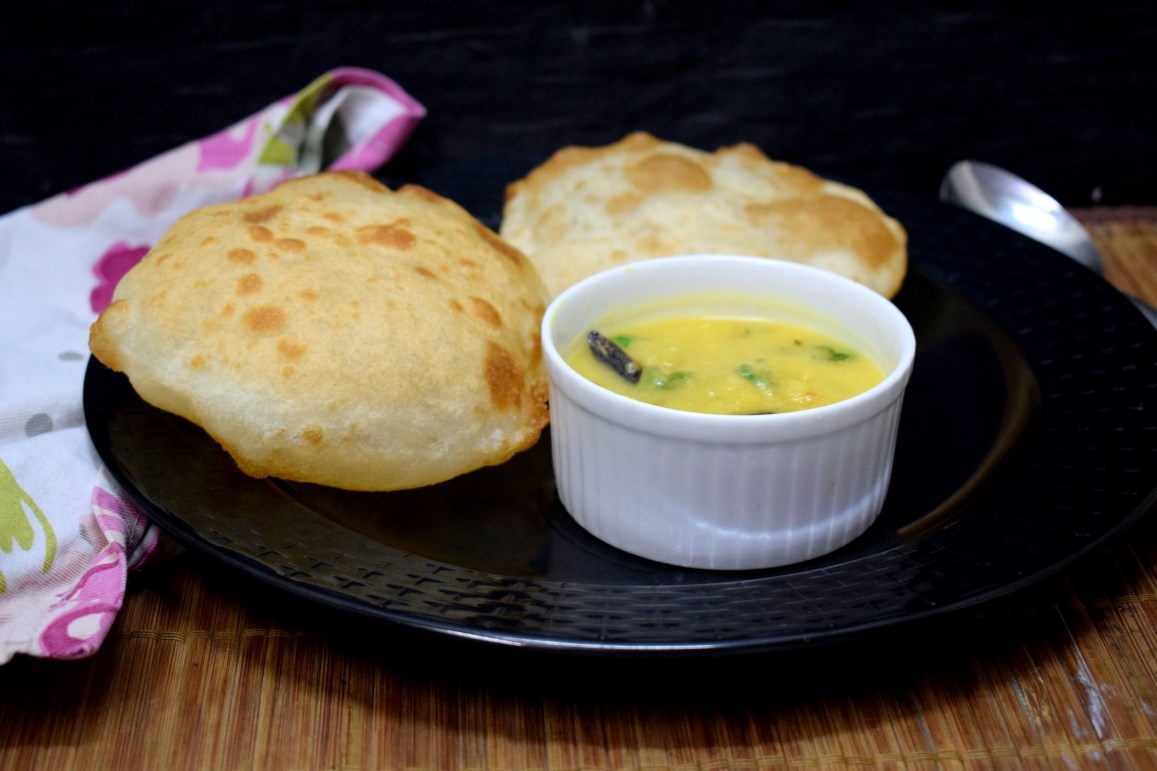Rontose is a deep-fried Rice Bread made for a leisure weekend special breakfast. This popular Konkani delicacy is served with Dalithoy, a dal made with Toor and Potato.
This Rontose is also called Rontoso or Rontus or just Rontos. The side dish served with these Rice Pooris is a dal made with Toor and Potatoes in a simple tadka. Again this simple dal is called Thoi or ani thoy or Dalithoy.
Whenever I plan my AtoZ series, I always fall back to the different Melas I have conducted in the past and I must have got a reference to this. I also remember bookmarking it when Ranji had shared it a long time back. The recipe sometimes is made with just rice flour or with a mix of maida or wheat flour.
I followed Ranji's recipe for both the Rontose and the side dish that is served called the Dalithoy made with toor dal and Potato. However, as expected there are so many different recipes on the net and the recipes are quite simple. Since I have many rice flour pooris from different states, I was happy to make a combination of maida added to the poori.
One of the main differences in making these pooris is the use of a presser used to roll out the pooris. The balls are placed between the plates and pressed. If the presser is not available, we can use two plastic sheets and pressed them to thin discs.
These pooris are made on weekends served with a dal made with toor and potato. The dish is called Thoy or Dalithoy or Ani Thoy, is a thin dal tempered with tempering ingredients. Since I added maida to the flour, the pooris remain puffed up and crispy.
These are the final ones for this month in the A to Z Indian Poori for alphabet R.

PIN This for Later!

Step By Step Pictures for making Rantose




 Ingredients Used to make Rontose
Ingredients Used to make Rontose
Many recipes use only Rice Flour. However, some use 1/4th part of the dough with maida as well.
Pooris will end up hard if you cook it for a long time as maida is used.
Rontose is made using a presser, if you don't have the presser, you can use a greased plastic sheet and press the balls.
The dough is prepared with hot water, mixed, and let to rest for 10 mins.
Since hot water is poured into the flour, use a spoon and mix well till you can handle the hot water.
Knead well till you get a soft dough and let it rest for 10 mins.
Unlike poori which is flattened using a rolling pin, rontose requires a presser to flatten it evenly. If you don't have the presser, you can put the ball in between 2 greased plastic sheets and press it down using a flat bottom pan.
As I didn't have the presser, I used two sheets greased with oil.
Place the balls between the sheets, using a bowl, press well to press down into thin discs.
When the oil is hot, gently slide in and fry it on both sides.
Drain the pooris to a kitchen towel.
Serving Suggestions
Thin dal made with toor and potatoes is made as a side dish for these pooris.
The combination is served by placing 3-4 Rontose on a plate and lavishly pouring the thin Dal over it.
Since we didn't realize this and ended up making the dal a little thick and scooped the pooris with the dal.

Recipe
Rontose | Konkani Rice Poori ~ A to Z Indian Pooris
Ingredients
- 2 cups Rice Flour
- 1 cup Maida / Wheat Flour
- Salt to taste
- 1 3/4 cup Water hot
Instructions
- Take a wide bowl with rice flour and maida with salt.
- Add the hot water slowly and using a spoon mix well.
- When you can handle the flour, knead together to form a soft dough.
- Let it rest for 10 mins.
- Heat a kadai with oil and when it is hot, start making the pooris.
- Divide into balls and using a greased plastic sheets, press the balls into thin discs.
- Slide the discs into hot oil and fry on both sides.
- Press the pooris to puff it up.
- Drain to a kitchen towel.
- Serve with Dalthoy
This was part of the AtoZ series I did on Indian Pooris, for the entire collection of A to Z Indian Pooris, check the roundup.
If you are looking for different options for Indian Breakfast and feel adventurous about making it in alphabets, do see the roundup of A to Z Indian Breakfast dishes.







Suma Gandlur says
These rice flour pooris have been on my list for decades. 🙂 Your pooris have turned out great.
Rafeeda - The Big Sweet Tooth says
This is something totally new for me. We do have neypathil which is made with rice flour or batter made with soaked rice, but combining rice flour and maida to make these is something very interesting. Let the summer pass, then I would love to try this... Pinning it up...
Vaishali says
Awesome ! Something absolutely new and interesting . How I wish my folks were fond of pooris . I feel like trying all from this series . Well I shall try anyways - even if I have to eat all by myself . Ehe he .,
Harini Rupanagudi says
Unique combination of maida and rice flour. Those pooris look sinful.